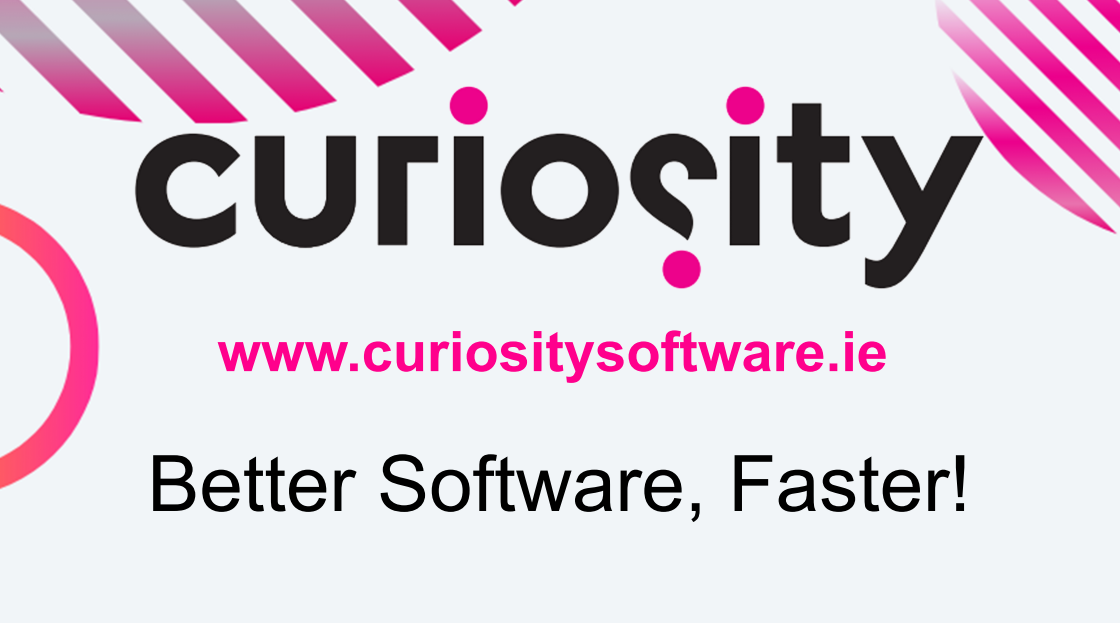Second decade of a new millennium: observations and predictions for QA
The past decade has seen me sell one start-up, join a multi-national, and co-found my latest venture: Curiosity Software Ireland. I am grateful for...
Design Complex Systems, Create Visual Models, Collaborate on Requirements, Eradicate Bugs and Deliver Quality!
| Product Overview | Solutions |
| Success Stories | Integrations |
| Book a Demo | Release Notes |
| Free Trial | Brochure |
| Pricing |
Our innovative solutions help you deliver quality software earlier, and at less cost!
![]() AI Accelerated Quality Scalable AI accelerated test creation for improved quality and faster software delivery.
AI Accelerated Quality Scalable AI accelerated test creation for improved quality and faster software delivery.
![]() Test Case Design Generate the smallest set of test cases needed to test complex systems.
Test Case Design Generate the smallest set of test cases needed to test complex systems.
![]() Data Subsetting & Cloning Extract the smallest data sets needed for referential integrity and coverage.
Data Subsetting & Cloning Extract the smallest data sets needed for referential integrity and coverage.
![]() API Test Automation Make complex API testing simple, using a visual approach to generate rigorous API tests.
API Test Automation Make complex API testing simple, using a visual approach to generate rigorous API tests.
![]() Synthetic Data Generation Generate complete and compliant synthetic data on-demand for every scenario.
Synthetic Data Generation Generate complete and compliant synthetic data on-demand for every scenario.
![]() Data Allocation Automatically find and make data for every possible test, testing continuously and in parallel.
Data Allocation Automatically find and make data for every possible test, testing continuously and in parallel.
![]() Requirements Modelling Model complex systems and requirements as complete flowcharts in-sprint.
Requirements Modelling Model complex systems and requirements as complete flowcharts in-sprint.
![]() Data Masking Identify and mask sensitive information across databases and files.
Data Masking Identify and mask sensitive information across databases and files.
![]() Legacy TDM Replacement Move to a modern test data solution with cutting-edge capabilities.
Legacy TDM Replacement Move to a modern test data solution with cutting-edge capabilities.
See how we empower customer success, watch our latest webinars, read our newest eBooks and more.
![]() Events Join the Curiosity team in person or virtually at our upcoming events and conferences.
Events Join the Curiosity team in person or virtually at our upcoming events and conferences.
![]() Blog Discover software quality trends and thought leadership brought to you by the Curiosity team.
Blog Discover software quality trends and thought leadership brought to you by the Curiosity team.
![]() Help & Support Find a solution, request expert support and contact Curiosity.
Help & Support Find a solution, request expert support and contact Curiosity.
![]() Success Stories Learn how our customers found success with Curiosity's Modeller and Enterprise Test Data.
Success Stories Learn how our customers found success with Curiosity's Modeller and Enterprise Test Data.
![]() Documentation Get started with the Curiosity Platform, discover our learning portal and find solutions.
Documentation Get started with the Curiosity Platform, discover our learning portal and find solutions.
![]() Integrations Explore Modeller's wide range of connections and integrations.
Integrations Explore Modeller's wide range of connections and integrations.
Curiosity are your partners for designing and building complex systems in short sprints!
![]() Meet Our Team Meet our team of world leading experts in software quality and test data.
Meet Our Team Meet our team of world leading experts in software quality and test data.
![]() Our History Explore Curiosity's long history of creating market-defining solutions and success.
Our History Explore Curiosity's long history of creating market-defining solutions and success.
![]() Our Mission Discover how we aim to revolutionize the quality and speed of software delivery.
Our Mission Discover how we aim to revolutionize the quality and speed of software delivery.
![]() Our Partners Learn about our partners and how we can help you solve your software delivery challenges.
Our Partners Learn about our partners and how we can help you solve your software delivery challenges.
![]() Careers Join our growing team of industry veterans, experts, innovators and specialists.
Careers Join our growing team of industry veterans, experts, innovators and specialists.
![]() Press Releases Read the latest Curiosity news and company updates.
Press Releases Read the latest Curiosity news and company updates.
![]() Success Stories Learn how our customers found success with Curiosity's Modeller and Enterprise Test Data.
Success Stories Learn how our customers found success with Curiosity's Modeller and Enterprise Test Data.
![]() Blog Discover software quality trends and thought leadership brought to you by the Curiosity team.
Blog Discover software quality trends and thought leadership brought to you by the Curiosity team.
![]() Contact Us Get in touch with a Curiosity expert or leave us a message.
Contact Us Get in touch with a Curiosity expert or leave us a message.
6 min read
 Thomas Pryce
10 July 2018 16:42:14 BST
Thomas Pryce
10 July 2018 16:42:14 BST

This is part one of three of the “Philosophy of Application Delivery” eBook. The eBook contains Curiosity Software Ireland’s musings on the nature of effective application delivery, while introducing VIP, the new “Rapid application assembly Framework”. All of this is done within a brief tour of several major schools of Western philosophy from the past two millennia.
We learn in high school philosophy that ‘everything is a footnote to Plato’. Everything would have to apply to application delivery too. This blog considers insights for quality application delivery from Plato (427-347 BCE) and his pupil Aristotle (384-322 BCE).
Aristotle is often hailed as a founding figure within empiricism. If we want to know about something, observe it; to know what virtue is, Aristotle describes in the Nicomachean Ethics, observe the virtuous person.
If we look to Aristotle the man, we find someone who continually experimented, and meticulously compiled their findings. Aristotle’s volumes of zoology and natural scientific observations, for instance, have proven so rich that some of their more surprising conclusions are still being verified today.
So too with application delivery. Inherently empirical, we record user needs, produce code, formulate tests, run them, and record the results. These assets are created based on a prior understanding of a system, and what is observable within it. We then correct our understanding when previously unknown elements are uncovered, feeding this back into requirements and TestDev assets.
The more we observe, the more we learn. This is true from the initial and ongoing collaboration between requirements gatherer and user, to smoke testing, end-to-end automated functional testing, and eventual user acceptance tests. These observations can then be fed back into the documented understanding of the system, working like Aristotle to fully understand the user’s desired functionality.
Throughout this process, we need to know how the system is intended to function. Testers, for instance, need expected results with which to compare and verify actual results, considering how the system works in relation to the recorded understanding of how the user wants it to work.
This takes us to Aristotle’s predecessor and teacher, Plato, in a sense the first model-based tester. In Plato’s theory of forms, we are told that every instance of what exists in our world is a reflection of an ideal ‘form’. In the world of forms, there is the form of the ideal chair and the ideal good, both of which are found reflected in the world of matter.
Only the philosophers who liberate themselves from a focus on the material world can climb to the world of forms. The rest of us are sitting in a cave, watching comforting shadows pass by on a wall in front of us, mistaking them for true forms.
Figure 1: Plato’s Analogy of the Cave.
These philosopher kings plan and manage Plato’s Republic. They are responsible for contemplating the blueprint of the ideal city and implementing it in practice. This blueprint is not absolute or timeless, with each philosopher king sitting for a set period and improving the plan for the city.
In the traditional delivery cycle, elements of this approach can work hand in hand with the empiricism discussed above.
Stakeholders across a sprint or delivery pipeline act as philosopher kings, working to ascertain the user’s desired functionality, while validating that it is being fulfilled. They translate this understanding into a blueprint of the ideal system, housed in requirements and models. From this blueprint, code and tests are derived.
The tests are then executed, with the results compared to the ideal system. The blueprint itself can then be updated to reflect any new knowledge of how to fulfill the user’s needs, before updating and retesting the system in the next iteration.
In this traditional delivery cycle, however, challenges emerge by virtue of poor alignment between stakeholders. Business analysts will still often formulate requirements, pass them to developers, who then convert them to code. Testers might then translate the requirements into test cases, laboriously attempt to locate the right data to execute them, and then try to communicate their results accurately back to the developers.
Each stage introduces the potential for miscommunication and an ever-greater degree of inherent uncertainty. Delays further mount as a result of the manual labor of converting requirements, development, and test assets from one stage and format into another.
This is true in Agile environments, where sprints frequently resemble mini-waterfalls, and silos engrained in organizational processes disrupt the information flow. Meanwhile, differing technologies quickly pile up in the individual teams, exacerbating the labor of having to assemble functioning systems and automated business processes.
Once-called “business” stakeholders and those with “deep” technical skills need to be brought into closer alignment. Meanwhile, the siloed, conveyor-belt approach should be abandoned in favor of parallel productivity.
“Low code” capabilities offer one way to achieve this, when implemented with the right tools and processes. “Technical” teams can enable the “business” to leverage and re-use their code and automation components in future development cycles, freeing developers and testers to focus on delivering continual innovation.
“Visual Integration Processor” (VIP), the new solution from Curiosity Software Ireland, can support organizations in achieving this stakeholder alignment. Users can collaboratively build a central repository of re-usable components, which includes automated business processes, as well as system logic like code and message calls, and automated test scripts.
This central repository functions like a library of re-usable lego blocks, allowing stakeholders with minimal coding knowledge to leverage the efforts of DevTests and automation engineers. A BA, for instance, can drag and drop the re-usable components to the VIP canvas, quickly assembling them into a functional model or automated business process.
A BA might use this model-based approach as a form of declarative programming, assembling functioning prototypes of a feature or component, equipped with the data and service calls needed to execute it. Testing can therefore occur in parallel with ideation, allowing the “Business-DevTest” to exercise fail-fast experiments against their model.
BAs can thereby garner early insights and eliminate defects before the time and cost has been spent developing and testing the feature of automated process flow. The model-based approach used in VIP is furthermore flexible, so that the first-day testing is run as the model is being created and updated according. BAs can thereby work like Plato’s philosopher kings to better their understanding of user needs, and as Aristotle to improve the corpus of observations.
VIP can similarly remove all-too-familiar bottlenecks with easier, accelerated Business Process Automation. BAs can quickly work from the repository to assemble working flows to automate laborious tasks, without having to constantly reinvent the wheel.
A simple but all-too-common example is the proliferation of PDFs in many large organisations, and the laborious task of scraping data from them to put into another, usable format like spreadsheets. VIP has been used to automate this process, freeing BAs to focus on identifying user needs, and driving further innovation and efficiency savings.

Figure 2: A VIP flow used to convert a PDF attached to a supplier email into Excel, before validating the data it contains and exporting it to the BI Dashboard. Looping capabilities mean that this is a continual process, whereby the upfront, one-off investment in creating the flow quickly pays for itself in time saved.
The role of the techie remains, but their time is freed up for innovation, while the value of the resources created via hand-coding or scripted automation is maximized by virtue of the re-usability of these one-off labors.
Many tools aim for enhanced or simplified communication channels between business and technical stakeholders. This is invaluable, and VIP offers integration into Slack and Facebook as part of its “ChatOps” functionality. However, VIP further empowers individual stakeholders to maximize their self-sufficiency and efficiency, leveraging the one-off labors of others to reduce the delays associated with repeated or overlapping efforts, and repeatedly asked questions.
The rate of innovation is thereby increased. Developers, testers, and DevTests can further benefit from VIP’s “Rapid Application Assembly Framework”. This not only allows them to re-use individual components created by others, but reduces the efforts of manually integrating the moving parts of a system.
VIP instead allows systems or process flows to be assembled rapidly and visually, better understanding the complex logic and working to avoid the frustration when a hand coded integration falls down due to a mystery component failing.
The labor of hand coding the “plumbing” or glue that holds a system together is also thereby reduced. VIP facilitates this through connectors into spreadsheets, popular data formats, APIs, test automation frameworks, and project management tools, to enable smooth process automation enterprise-wide
VIP accordingly uses a model-based approach to accurately capture an evolving system or automated business processes. This facilitates the rapid assembly of test automation frameworks, efficient “low code” and hand code development, and accurate business process automation.
New insights into the system or user needs can be garner continually with this approach, iteratively updating the central repository of re-usable objects and enhancing the models in accordance with the latest observations. Distributed teams can collaborate like an organized collective of observant Aristotles, using automated tooling to facilitate thinking and faster experimentation.
These observations feed into a flexible model of the business process or system under test and development. However, whereas the maintenance of the ideal Republic was the prerogative of philosopher kings for Plato, VIP aims to facilitate a collaborate approach between “citizen developers” working enterprise-wide with maximal self-sufficiency for maximal efficiency.

The past decade has seen me sell one start-up, join a multi-national, and co-found my latest venture: Curiosity Software Ireland. I am grateful for...

The new tool scales generative AI throughout DevOps and CI/CD, providing visibility, optimal test generation, pipeline integration and cross-team...

Welcome to part 2/5 of 5 Reasons to Model During QA! Part one of this series discussed how formal modelling enables “shift left” QA. It discussed how...

In the digital age, large enterprises are plagued by a lack of understanding of their legacy systems and processes. Knowledge becomes isolated in...

APIs are the lifeblood of modern software systems. They enable organisations to reach across technologies and their users, rapidly exposing systems...

Welcome to part 3/5 of 5 Reasons to Model During QA! Part one of this series discussed how modelling enables “shift left” QA, eradicating potentially...

The QA community has been buzzing this past month as its members and vendors respond to Angie Jones’ insightful article, 10 features every codeless...

In the world of software development, generative AI has established itself as a formidable ally, assisting developers in coding and detecting...

Application development and testing has been revolutionised in the past several years with artifact and package repositories, enabling delivery of...